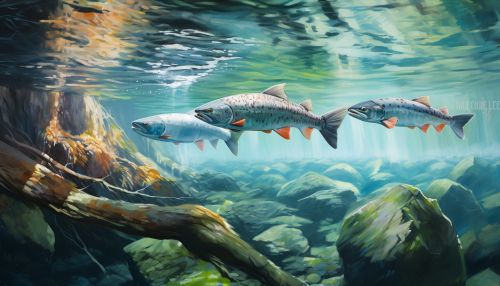Anadromous Migration
Introduction
Anadromous migration refers to the large-scale migration of certain species of fish from the sea to freshwater rivers for breeding. This type of migration is a common phenomenon in several species of fish, including salmon, sea lamprey, shad, and striped bass. The term "anadromous" is derived from the Greek words "ana," meaning "up," and "drome," meaning "a running."


Biological Mechanism
Anadromous fish are born in freshwater, migrate to the sea to grow and mature, and then return to freshwater to spawn. This migration pattern is driven by a complex interplay of environmental cues, physiological changes, and genetic programming. The exact mechanisms that trigger anadromous migration are still not fully understood, but it is believed that changes in water temperature, day length, and hormone levels play a significant role.
Environmental Factors
Environmental factors play a crucial role in anadromous migration. The timing of migration is often linked to seasonal changes in the environment. For example, many anadromous fish species migrate to freshwater rivers in the spring when water temperatures are rising. This timing ensures that the eggs and larvae have the best chance of survival.
Physiological Changes
Anadromous fish undergo significant physiological changes during their migration. These changes are necessary for the fish to survive in both freshwater and saltwater environments. The most significant change is the switch from a saltwater to a freshwater physiology, a process known as smoltification. This involves changes in the fish's gills, kidneys, and skin to allow it to excrete excess salts and absorb freshwater.
Genetic Factors
Genetic factors also play a role in anadromous migration. Some fish species have specific genes that predispose them to migrate. These genes are passed down from generation to generation, ensuring that the migration pattern continues.
Impact on Ecosystem
Anadromous fish play a vital role in their ecosystems. Their migration brings nutrients from the ocean into freshwater rivers, benefiting both the river ecosystem and the terrestrial ecosystem surrounding it. Additionally, anadromous fish are an important food source for many animals, including bears, eagles, and humans.
Threats and Conservation
Anadromous fish face several threats, including habitat loss, pollution, overfishing, and climate change. These threats have led to declines in many anadromous fish populations. Conservation efforts are underway to protect these species and their habitats. These efforts include habitat restoration, pollution control, sustainable fishing practices, and the establishment of protected areas.
